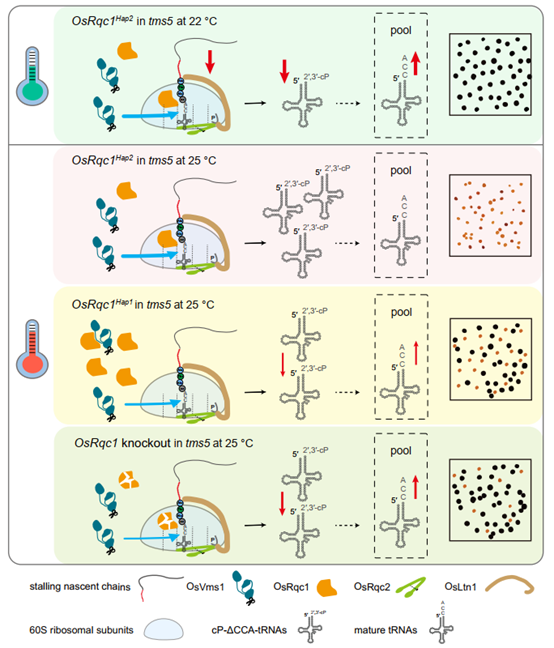Hybrid rice technology is a significant advancement in China’s agricultural innovation. The two-line hybrid rice system, a cutting-edge hybrid rice breeding technology, has greatly boosted global food security. In thermo-sensitive genic male sterile (TGMS) lines, the critical sterility-inducing temperature (CSIT; the temperature at which TGMS lines change from male fertile to complete male sterile) acts as a key threshold. Previously, researchers found that thermo-sensitive genic male sterility 5 (tms5), a sterile locus present in over 95% of TGMS lines used for two-line hybrid rice production, is a loss-of-function allele of a gene encoding the ribonuclease RNase ZS1.
A research paper just published in
Science China Life Sciences (
https://doi.org/10.1007/s11427-025-3018-9) reports that the rice ribosome-associated quality control 1 (OsRqc1) regulates the temperature threshold in
tms5 lines by assisting OsVms1 in recruiting 60S ribosomal subunits to generate cP-ΔCCA-tRNAs, with its allelic variations offering a novel tool for two-line hybrid breeding of japonica rice
tms5 lines.
The study is conducted by the collaboration between CAO Xiaofeng's group from the Institute of Genetics and Developmental Biology, Chinese Academy of Sciences, and YANG Yuanzhu from the Yuan Longping High-Tech Agriculture Co., Ltd.
TGMS lines are fertile at lower temperatures but male sterile above a CSIT, which varies substantially across TGMS lines and is crucial for ensuring the seed production safety of two-line hybrid rice. The team identified a CSIT-related gene OsRqc1, which encodes a rice ribosome-associated quality control 1 (Rqc1) homolog OsRqc1. OsRqc1 binds to OsVms1, helping it recruit 60S ribosomal subunits and acting as a structural adaptor between OsVms1 and stalled subunits. Consequently, in the absence of OsRqc1, cP-ΔCCA-tRNA accumulation decreases, and the levels of mature tRNAs are partially restored, thereby raising the CSIT in tms5 lines. Variations in a 6-bp repeat in the 5′ untranslated region of OsRqc1 in rice subspecies affect its transcription, thereby altering the CSIT in tms5 lines.
These findings reveal the role of an OsRqc1–OsVms1 module in regulating CSIT, providing valuable insights into genetic variations in OsRqc1. Such results may facilitate the molecular breeding of rice two-line hybrid tms5 lines with specific CSITs, which can adapt to regions with different environments.
A proposed working model depicting the role of the OsRqc1–OsVms1 module in regulating the CSIT in tms5 lines (Image by IGDB)
Contact:
Prof. CAO Xiaofeng
Institute of Genetics and Developmental Biology, Chinese Academy of Sciences
Email: xfcao@genetics.ac.cn
 A proposed working model depicting the role of the OsRqc1–OsVms1 module in regulating the CSIT in tms5 lines (Image by IGDB)Contact:Prof. CAO XiaofengInstitute of Genetics and Developmental Biology, Chinese Academy of SciencesEmail: xfcao@genetics.ac.cn
A proposed working model depicting the role of the OsRqc1–OsVms1 module in regulating the CSIT in tms5 lines (Image by IGDB)Contact:Prof. CAO XiaofengInstitute of Genetics and Developmental Biology, Chinese Academy of SciencesEmail: xfcao@genetics.ac.cn CAS
CAS
 中文
中文




.png)
